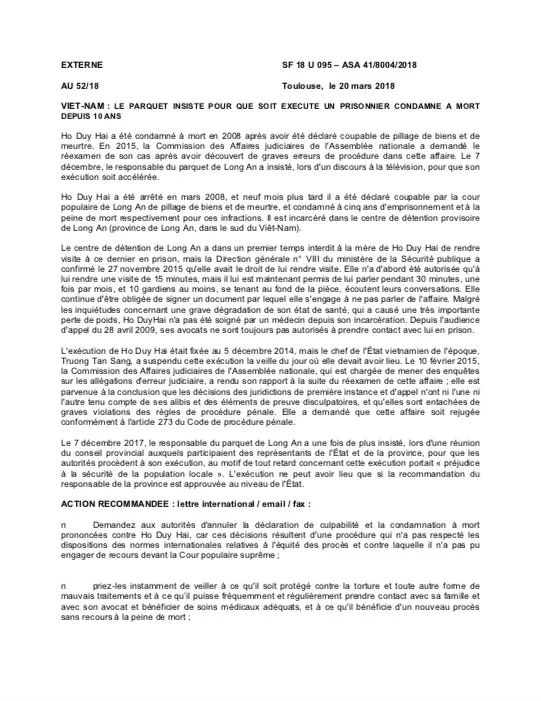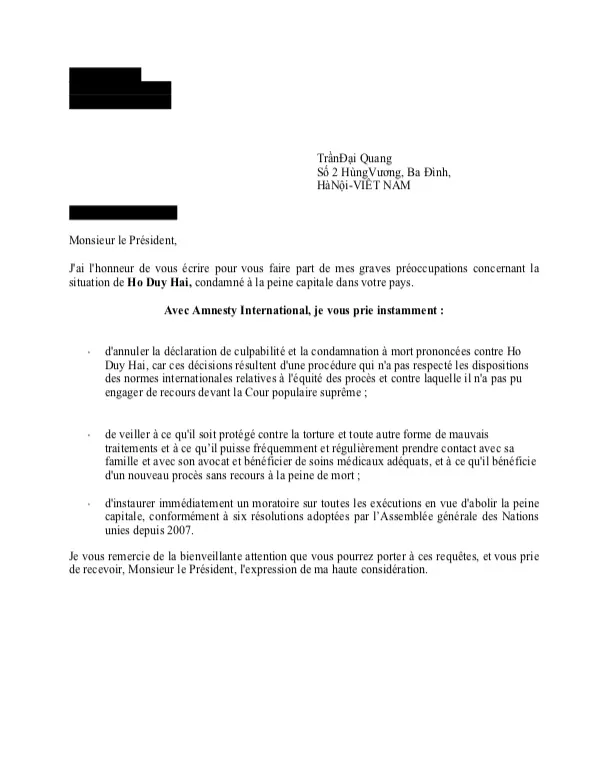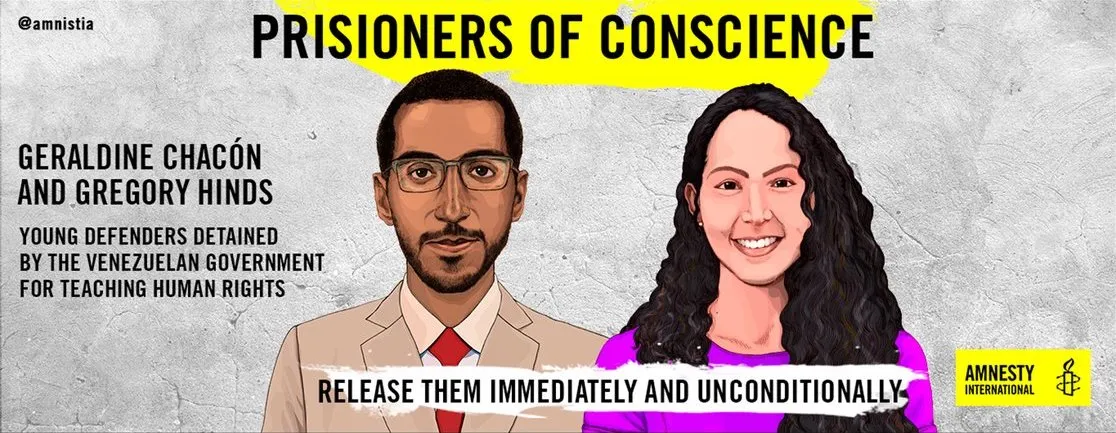
Helping Amnesty International Target a New Audience

In 2016, we committed to give some of our time to charities. A year ago, we found a project that brings a purpose to what we do every day: widen the Amnesty International Urgent Action Network with the help of Lean Startup and cutting edge technology.
What is it about?
Saving Lives With an A4 Paper
Urgent Action abstract, full document
Amnesty’s Urgent Action Network mobilizes volunteers, asking them to write letters quickly to protect human rights and save lives.
How does it work? Investigators are spread all around the globe where human rights are at risk. Whenever they notice someone in imminent danger, they write a report on a recto-verso A4 page and send it to Amnesty International.
That’s where the network kicks in. That A4 page is sent down to the members of the network as fast as possible. Immediately after being alerted, the writers write and send letters to the responsible authorities within a couple of days. Those authorities usually are embassies, governors, prosecutors or secretaries of state. Flooding them with thousands of letters from across the world gives them a message: “we see what you’re doing”, it creates pressure to stop the violation.

Urgent Action letter, full document
And it works! According to Amnesty, the Urgent Action Network has a positive impact in about 30% of the cases: it’s the activism method that works best (especially when compared to petitions, which have less and less impact).
The Problem
Why would we want to change something that is already very effective?
Amnesty noticed that writers are mostly retired persons gathering together to write letters. They invest a lot of time responding to the urgent actions, because they know that’s what it takes. It works, and no change is intended on that front.
But Amnesty fails to renew the population of the Urgent Action Network. Younger activists aren’t attracted to the network, even though its action is very effective. There have been huge changes in the way the younger generations live their lives: time is precious, attention span is very limited, retaining people is much harder. Amnesty has to adapt to the new usages in order for the Urgent Action Network to get bigger.
The Idea: Digitalize the Urgent Action Network
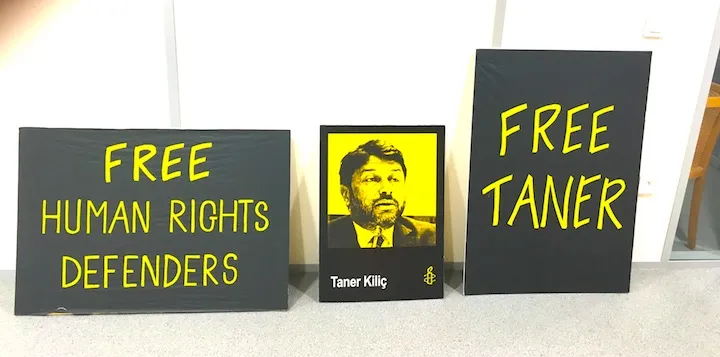
To address that new target effectively, Amnesty thought of a mobile application. One that could make activists save a lot of time and that would retain their attention for as long as possible, proposing a very different experience from the single recto-verso A4 page. To confirm they were going in the right direction, they ran a survey on about 300 people in their target audience.
Most people confirmed that:
- Writing letters takes too much time
- They weren’t helped enough while redacting the letter
- They weren’t hooked because:
- they didn’t know what happened after sending the letter
- they didn’t know many other people were involved as well
Our production vision started to appear:
For young and/or active amnesty supporters,
who want to act concretly when someone is in imminent danger of serious human rights violations
our product is a digital service
that helps rightholders in a quick and real way.
Unlike petitions or rallies
our product helps act immediately, in a simple and effective way, on mass personified-letters sending. It strongly and continuously engages users by valueing their individual and collective action.
Exploration
We knew what the problems were, we then needed to explore the possible solutions. For that use, we ran a workshop where everyone shared their ideas. No limits, even the craziest ideas help go forward. We then gathered them by theme and discussed each of it.
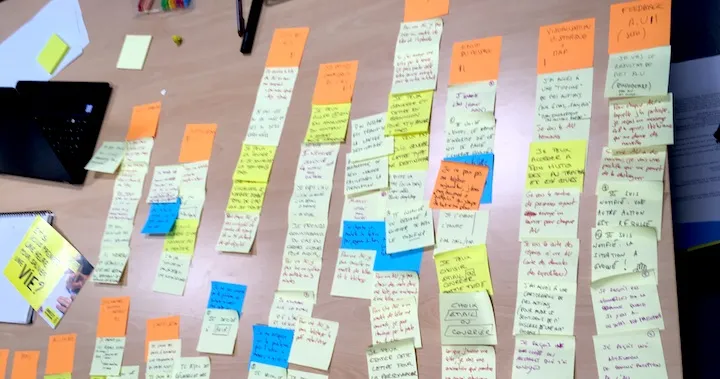
Some examples of ideas that went through this process, from the point of view of the user:
- The summary of the subject of the urgent action should be attractive so that I don’t lose track.
- The letter should be written on my behalf but should be customizable by hand, or by selecting different writing styles, or by expressing how I feel about the situation.
- I should be able to invite my friends and family to take part in the urgent action I’ve just participated in.
- I want to be able to send the letter without going to the post office, even if I have to pay for it.
- I want to have news about the urgent actions I’ve participated in, whether the situation gets better or not.
- There should be something letting me know that I’m not alone and that’s it’s our collective action that makes a difference.
- I can share the letter I’ve written to help other activists.
Identifying Uncertainties
We had a lot of ideas, but ideas only are convictions. From our small survey, and from our design work, we only thought those ideas would bring value to our users.
Since we addressed a new target, we only knew so much about our users. When making assumptions about what they want, we take the risk of not building something they will like to use. These assumptions are, in fact, leaps of faith.
How do we un-risk this? We need to identify and prioritize our assumptions by the value they bring to our model:
- Writing the letter on behalf of the user doesn’t decrease urgent actions effectiveness
- Writing the letter on behalf of the user doesn’t decrease engagement because it’s simpler
- We have enough input to produce attractive stories for urgent actions
- The new target doesn’t need to produce as much effort as the current target to feel a sense of self-worth
- Social sharing is a good lever to community growth
Then, we need to design an experiment for the most risky assumptions as quickly as possible. That’s a subject we’ll address in the next posts in this series.
Conclusion
Amnesty’s project is typical of what we do at Marmelab: turn an existing product or service into a more effective one by focusing on the target population, identifying assumptions, and testing them one by one.
As compared with other projects we do, by building something with Amnesty, we dedicate our expertise to the greater good. This makes our work have a different taste: there is nothing better than helping the ones who really need it.
This post is one of a series. Make sure you read the next one, explaining how we designed the experience for Amnesty activists.
Authors

Facilitator at marmelab, Florian also gives lectures to IT students. He's a biker, plays the guitar, and brews his own beer.
